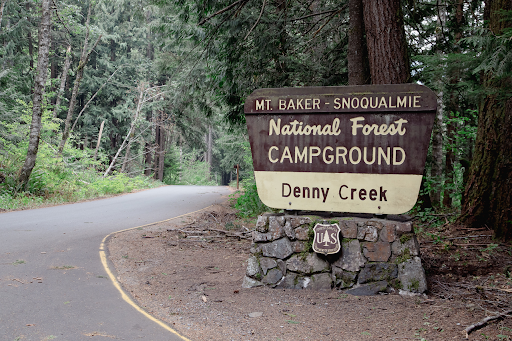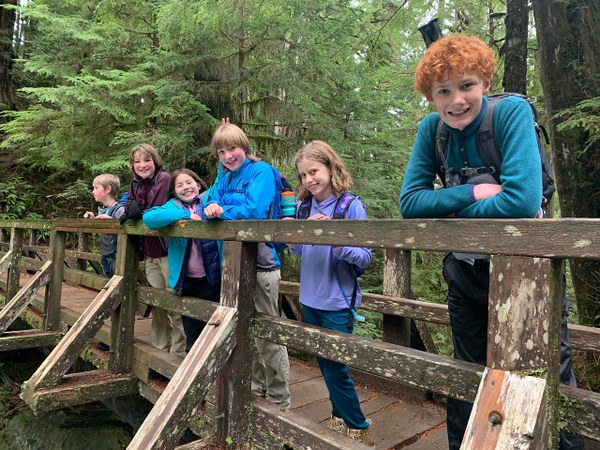
Washington state has it all when it comes to outdoor recreation opportunities: an idyllic coastline, jagged peaks, and golden larches. But unfortunately, eroded trails, ancient bathrooms, washed out roads, and other challenges can prevent outdoor enthusiasts from experiencing the restorative power of our public lands.
Thankfully, we took a significant step toward addressing these issues through the passage of the Great American Outdoors Act (GAOA) in 2020 after years of advocacy by our members, partners, and staff. There are two major pieces of the GAOA: full and permanent funding for the Land and Water Conservation Fund (LWCF), and the establishment of the National Parks and Public Land Legacy Restoration Fund (LRF). GAOA funding is helping land managers address the backlog of maintenance projects needed to restore trails, campgrounds, parking lots, and other facilities on our public lands.
A large portion of GAOA funding is being used to fix deferred maintenance issues in the Mount Baker-Snoqualmie National Forest (MBSNF). With its close proximity to the greater Puget Sound area and diversity of vistas ranging from glaciated peaks to old-growth forests, it’s no wonder that the MBSNF is one of the most visited national forests in the country.
More visitation means that tackling deferred maintenance projects is as important as ever to ensure that recreational use is sustainable now and into the future. Let’s take a closer look at how several GAOA funded projects - ranging from recently completed to recently funded - will help us preserve and sustain the Mount Baker-Snoqualmie National Forest for generations to come.
Denny Creek and Franklin Falls
Currently, 17 projects funded by the GAOA are scheduled to be completed along the Mountains to Sound Greenway National Heritage Area. One of those projects just wrapped up: Denny Creek and Franklin Falls, two extremely popular hikes near Snoqualmie Pass, are open after a five-month closure. With minimal elevation, proximity to the greater Seattle area, and gorgeous views, the trailhead parking lots often fill by 7am on a sunny weekend, forcing cars to park along the narrow, one-way road leading to the trails. This is ecologically damaging to the surrounding forest and a potential safety hazard. In the event of an accident, Search and Rescue may not be able to squeeze their trucks into the trailhead.
Recognizing the need for change, Mount Baker-Snoqualmie National Forest used GAOA funding to mitigate many of these issues. The project created a paved parking lot that has 170 designated parking spaces (the former Franklin Falls lot only had 30) and turned the road leading to the trailhead into a loop to alleviate traffic congestion concerns. It also added more ADA-accessible parking spots. Now, Franklin Falls and Denny Creek are accessible and safer - just in time for snowshoe season.
Annette Lake
It’s been a busy season for GAOA projects. Rehabilitation of the Annette Lake Trail, another popular hike in the Snoqualmie region, is nearly complete.
The Annette Lake Trail is an accessible destination for many Washingtonians - around 3.6 million people live within 70 miles of the trailhead. Heavy foot traffic means the trail needs continuous upkeep to ensure the area stays safe for current and future hikers and to sustain a healthy ecosystem.
Unfortunately, a lack of funding for these maintenance projects over the years has led to significant erosion along parts of the trail. Hikers have twisted their ankles on eroded sections of trail, requiring Search and Rescue intervention, and erosion-induced soil runoff has impacted streams and amphibians in the area.
That’s why the Annette Lake Trail Restoration Project is a huge win for recreationists and the area’s ecological health. The project will restore 2.6 miles of trail with better erosion control and safety features, including crib ladder steps. These rehabilitation efforts will protect the landscape and the thousands of people who visit the trail each year.
Thanks to the hard work of volunteers and organizations, including Mountains to Sound Greenway Trust, WTA, and the Snoqualmie Ranger District, the project could be completed as early as this month.
More Upcoming GAOA Projects
Over the next few years, you’ll likely see additional improvements to heavily-used recreation destinations throughout the Mount Baker-Snoqualmie National Forest. Along the Mountain Loop Highway, GAOA funding has been allocated to:
- Improve the trailhead and replace a bridge at Heather Lake.
- Conduct trail maintenance and bridge repairs at Lake 22.
Mount Baker-Snoqualmie National Forest has also received $480,000 in GAOA funding for deferred maintenance at the Heather Meadows Recreation Area. This investment will help maintain the fragile Heather Meadows ecosystem and the numerous recreation opportunities that the area provides.

 Explorers and Junior MAC students pose during their hike to Lake 22. Bridges like the one pictured above may be improved with GAOA funding over the next few years.
Explorers and Junior MAC students pose during their hike to Lake 22. Bridges like the one pictured above may be improved with GAOA funding over the next few years.
Looking Ahead to GAOA Reauthorization
Funding for the Great American Outdoors Act’s National Parks and Public Land Legacy Restoration Fund is set to expire at the end of September 2025. The good news is that any GAOA LRF-funded project that is started before the expiration date will still be completed, meaning many projects will likely continue beyond 2025, regardless of reauthorization.
But, we need continued funding of the LRF program if we want to fully address the many maintenance challenges impacting our public lands. That’s why we’ll be working with our partners and lawmakers to advocate for reauthorization of the Legacy Restoration Fund.
Thanks to advocacy by Mountaineers members and the wider outdoor community, we achieved a special conservation victory with the passage of the Great American Outdoors Act. We're going to need your voice during the push to secure additional funding for this landmark program. We'll share future opportunities to continue to advocate for restoring our public lands and the recreational opportunities they provide.
Interested in learning more about where GAOA funds are improving recreation on Washington’s national forests? Check out this USFS map of current and future GAOA projects.
 The Mountaineers
The Mountaineers